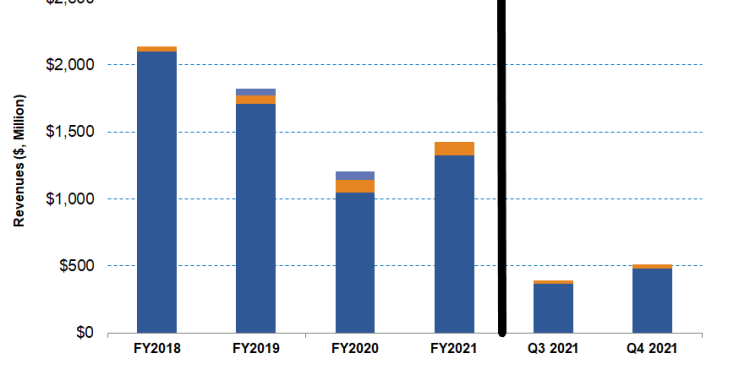- NexTier Oilfield’s Tier 4 dual fuel equipment remains sold out as the pricing differentials with the conventional frac spreads widen
- Inflationary costs will keep margin under pressure in the short term
- Negative cash flows and a high debt-to-equity ratio remains investors’ worries
Acquisiton Benefits And Other Challenges
NexTier Oilfield Solutions (NEX) is one of the largest wireline plug and perf providers through its integrated frac fleet services. Its Simulfrac fleet business offers a flexible business model, which meets the increased demand for last-mile proppant delivery logistic requirements. The other essential part of the strategy lies with the Alamo acquisition made in Q2 of 2021. The acquisition added nine CAT Tier IV hydraulic fracturing fleets to its asset base. The acquisition will also accelerate the Tier 4 diesel equipment upgrade more efficiently than converting Tier 2 equipment to Tier 4 dual fuel.
In the US onshore, the natural gas-powered frac fleets are in high demand, following the industry’s move toward increased efficiency and lower emission. Also, the well-completion activity will continue to grow in 2022. The company’s Tier 4 dual fuel equipment remains sold out. As the crude oil price increases, the cost of fuel for a frac fleet with diesel increases, leading to a higher demand for natural gas-propelled units. So, the pricing differential between natural gas-powered fleets versus conventional diesel-powered frac equipment will widen in an undersupplied market. However, the company’s integrated business model will face challenges due to the lengthening supply chain lead times and labor shortages.
Strategies: Integrated Model and Digital Technology

NEX focuses on a counter-cyclical investment strategy, which converts to natural gas-powered frac equipment. It has rolled out the Power Solutions natural gas fueling business which blends field gas and CNG to fuel frac fleets. The integrated frac plus fueling model will enable next-generation equipment by integrating completion services like wireline, frac, last-mile logistics, and power solutions. Despite the indicators moving upward, the frac pricing is still low compared to the historical average. So, it sold frac fleets in the Middle East and reduced nameplate capacity by 200,000 diesel horsepower, out of a total of 2.1 million horsepower capacity.
However, a need for more important strategic moves has come to the fore, including digital strategies. The shortage of tractor-trailers and truck drivers in the US has been addressed through the company’s NexTier solutions. It allows for maintaining priority relationships with many sand suppliers in the Permian Basin.
Counting On The Industry Drivers

In the past year, the drilled wells increased by 70% until January 2022, according to the EIA’s latest Drilling Productivity Report. The drilled but uncompleted wells (or DUC), in contrast, have declined by 8% during the same period. Higher West Texas Intermediate (or WTI crude oil) encouraged the drilled and completed well count hike.

According to Primary Vision’s forecast, the frac spread count (or FSC) reached 282 by the second week of March and has gone up by 16% since the start of 2022. Year-over-year, NexTier’s FSC increased by 24% until January. However, it can face downward pressure in the short term as utilization and frac pricing per stage supply chain disruption intensifies.
The Pricing Strategy And Q1 Forecast
NEX deployed a legacy Tier 4 dual-fuel fleet in the US in Q4 and upgraded Tier 4 dual-fuel fleet through the Alamo operations in Q1 2022. After completing the fleet upgrading program, the company plans to deploy a fleet of natural gas-powered equipment. Given the pre-text of supply chain constraints, the fleet deployment can repeat delays shortly as well, especially on Tier 4 DGB components.
While the input cost inflation continues to drive the cost up, utilization will maximize as demand increases. So, one factor may nullify the other, and in effect, NEX will see net pricing gains, which means the recapture of pricing concessions through Q1. So, the company will exit Q1 2022 with a “double-digits” adjusted EBITDA per deployed fleet run rate. Total revenue is expected to increase in the “low-to-mid-teens” percentage over the Q4 2021 growth rate.
Analyzing The Q4 Drivers

In Q4 2021, NEX’s revenues increased by ~30% compared to Q3 2021. Improved power solutions, wireline, cementing, and coil tubing resulted in revenue growth. The number of active hydraulic fracturing fleets increased to 31 in Q4, including the Alamo portfolio. However, fleet deployment slowed down in Q4 following the supply chain constraints, especially on Tier 4 DGB components. Despite some seasonal slowdown, the topline made a significant upward push due to the strong demand, improved fleet efficiency, and the added revenue from the Alamo acquisition.
NEX strengthened its Permian basin position in Q4. Compared to a quarter earlier, the adjusted gross profit also expanded substantially by 870% basis points. Much of the revenue and profit growth was concentrated in the Completion Services segment in Q4. The demand and pricing will likely continue to intensify due to the supply tightness in 2022.
Cash Flows And Liquidity
In FY2021, NexTier Oilfield’s cash flow from operations (or CFO) turned negative compared to a positive CFO a year ago. The CFO fall led to a decline in rig count and fleet utilization, along with pricing pressures from macroeconomic market conditions. On top of that, the company’s capex increased following the natural gas-powered equipment conversion program. As a result, the company’s free cash flow (CFO less capex) turned significantly negative in FY2021.
In 2022, the company will continue to invest in the Power Solutions business. Despite that, it expects to turn positive free cash flow following an improvement in margin and lower capex. For 2022, it plans to use the positive free cash flow generation to reduce net leverage or other capital allocation strategy, which may include M&A. The company’s liquidity totaled $317 million as of December 31, 2021. Its debt-to-equity ratio (0.69x) is higher than its competitors (BOOM, HLX, and DRQ).
Learn about NEX’s revenue and EBITDA estimates, relative valuation, and target price in Part 2 of the article.













